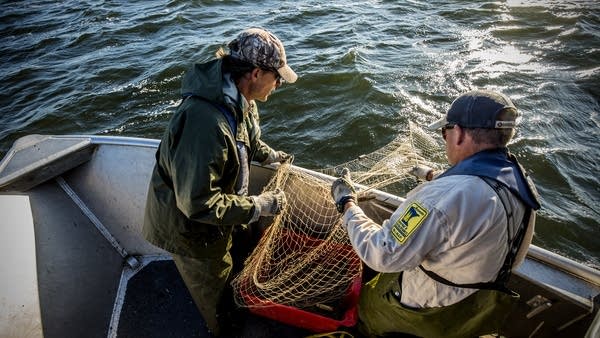Review of Mille Lacs walleye count doesn't satisfy critics

Go Deeper.
Create an account or log in to save stories.
Like this?
Thanks for liking this story! We have added it to a list of your favorite stories.
Critics of how the state estimates the walleye population of Lake Mille Lacs aren't entirely satisfied with the results of an outside review of how the Department of Natural Resources comes up with its numbers.
Those results were presented Monday night to the Mille Lacs Fisheries Advisory Committee by Dr. Chris Vandergoot, a biologist with the U.S. Geological Survey on Lake Erie in Michigan.
"We strictly looked on it from the perspective of is what the DNR doing represent good science relative to what other fisheries do," Vandergoot told the group.
As the state has tightened fishing regulations on Mille Lacs in recent years, resort owners and others have increasingly voiced skepticism over the low estimates the state has provided to justify lower walleye harvests. They say the dramatic decline suggested by the state doesn't reflect the abundance of fish they see every day.
Turn Up Your Support
MPR News helps you turn down the noise and build shared understanding. Turn up your support for this public resource and keep trusted journalism accessible to all.
Vandergoot's team didn't conduct their own studies. But they reviewed the DNR's data gathering methods, like gill netting, electrofishing and creel studies where anglers are asked about their catch.
Vandergoot says the DNR's efforts are standard practice and in some cases even exceed what's done on other big walleye lakes.

"While you might disagree with the way that the nets are allocated, the way that the spatial coverage is typically the way that the agencies set nets," he said.
A key question behind much of the skepticism is how to account for hooking mortality — the death of fish after they're caught and released.
"The bottom line is accounting for hooking mortality is common in freshwater recreational fisheries," Vandergoot said.
What's causing the decline cited by the state isn't clear. Scientists believe it's probably caused by a combination of factors, including warmer lake temperatures and greater transparency, invasive species like zebra mussels and a lack of forage fish for the walleye to eat.
Last summer, walleye fishing on Mille Lacs was catch and release only. And it was off limits entirely for about four weeks in July. This winter, ice anglers have been able to keep one walleye.
DNR officials hope using peer review will help increase transparency and rebuild trust with the Mille Lacs business owners who chafe at those regulations.
But Vandergoot's study focused only on the methods the DNR uses to gather information. That frustrated some members of the committee and audience, who wanted answers about how the DNR is using this data to estimate the lake's total walleye numbers and set regulations.

"I thought it was somewhat superficial and didn't really address the majority of the questions that we asked about," said lake resident Rick Wigand, who was at Monday night's meeting.
"I want to know how we can assess the population of fish in the lake because we don't think that it's been portrayed as what it really is," Wigand said. "Because the community up here is so dependent on the walleye as our economy. And so that way of life is kind of being destroyed."
Dean Hanson is a member of the advisory committee and owns Agate Bay Resort. He questions whether the gill nets used by the DNR are in the right locations to catch walleye given the lake's changing nature.
"We just don't find the extrapolation of that data and the conclusions that they reach to be logical based on what we see out on the lake," Hanson said. "I don't disagree with some of the conclusions that he reached. I just don't think that you can take those conclusions and say yes, everything they're doing about the lake as far as gathering data is correct and the best it can be."
Committee members talked about some next steps, like possibly using new technology like acoustic telemetry to track fish movements.
But it's clear that despite Vandergoot's work, the DNR likely will continue to face questions about whether it's doing everything it can to protect the lake's walleye population for future generations.


